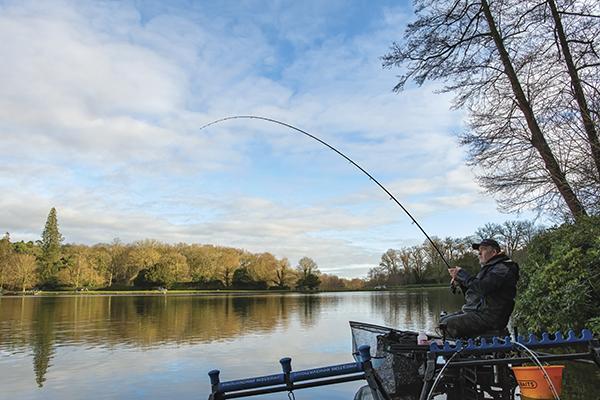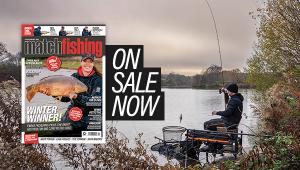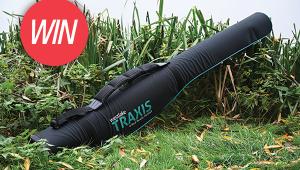Past Master

For this feature I’ve decided to bring you to one of my favourite winter haunts, Shearwater Lake near Longleat Safari Park in Wiltshire. It’s not just a beautiful place to fish, it’s also stuffed with roach, bream and some big carp and today I’m going to try and catch some bream and carp on the feeder. The water’s deep here and today it’s got just a tinge of colour, so it will be interesting to see if it’s going to be a bream day or a carp day… or both!
I’d love to catch some carp though, because they’re big, beautiful fish in here so fingers crossed I can get into one or two of them today. Carp normally figure in the matches but if they don’t feed you need to catch bream, and this is how I can catch both on the feeder.
The Swim
As with all winter fishing, swim selection is vital. This reservoir is typical of a man-made lake in that the banks slope down to a deeper channel that runs down the middle of the lake. There’s a rocky ledge though about 30 metres out and you have to be careful when playing fish that they don’t get near this and rub your line against the rocks, which can cause a breakage. The peg I’ve chosen is on the roadside and this seems to be more consistent for big fish than the swims on the opposite bank – I wouldn’t be unhappy to draw here in a match. There’s a good depth of about 16 feet where I’ll be chucking today and that’s at a distance of 55 and 65 metres.
Bait
The one great thing about fishing the feeder for bream and carp at this time of year is that everything on the bait tray is dead simple. There’s no need to complicate things when fishing the Method feeder, like I am today, and all you need is either pellets or groundbait to go around the feeder and a selection of hook baits.
Starting with the pellets, I’ve got a mix of 2mm Fin Perfect pellets and Pro Feed 2mm pellets. I like using the Pro Feed pellets because they’re more sticky than the Fin Perfects and help the pellets to mould on to the feeder. The sticky pellets are important on here because like I said earlier, it’s about 16 feet deep where I’m fishing so I need to squeeze some on firmly so they’re still on the feeder when it gets to the bottom. I’ll show you later how I mould the bait round the feeder because this is important. I’ve prepared about three pints of these because I’ll be feeding some at the start of the session with my Feeder Feeda rod.
I’ve also got some groundbait mixed up but I’m hoping that I don’t get to use it today. Groundbait can be massive on certain days but I won’t be starting on it today; I’ll save it for later and put some in if I’m struggling because it can turn things around if the fishing is hard on pellets.
Aside from the pellets and groundbait, all I then have is a tin of corn for using in my initial feed and maybe on the hook. Then it’s just an assortment of 8mm wafters in various colours that I’ll be using on the hook, and some dead maggots to use as hook baits if it’s hard and I need to target the smaller skimmers.
Rigs
Just like the bait, the rigs I’ve made up for today are very simple, but it’s important to have the right gear. The first rod is my Feeder Feeda rod and I think it’s important you all get yourself one of these for casting in those big feeders full of bait to get some feed down at the start of the session. I’ve got 25lb braid on the reel so I’m not messing about, and that’s tied direct to a large six-hole cage feeder for getting some bait into the swim initially. That’s clipped up at 55 metres.
I’ve then got two rods set up that are exactly the same, but they’re set at different distances. One is clipped up at 55 metres for fishing on the bait I’ll be introducing with the Feeder Feeda rod, and the other is set up at 65 metres for fishing 10 metres past my baited-up line. I won a match here last year doing this and it’s a tactic that I really want to show you today; fishing past your feed in the winter can be deadly and if you read my feature in last month’s fishing, you’ll know that I’m a big believer in going past my feed to catch bonus fish.
The rig itself is identical on both rods, which are 12ft 6in Supera 50g models, and I’ve got 6lb Sinking Mono main line and an 8lb shockleader of the same material. I’ve then got a 45g large ICS Method feeder that I’m using to begin with so I can get plenty of bait around the feeder, which I think you need on large, deep lakes like this. The weather has also been quite mild (but wet) so hopefully the fish will want a bit of bait today. Hooklength is 0.17mm to a size 14 KKM hook and I’ve got a hair rigged bait band on this because my hook bait to begin with will be a single 8mm wafter.
The Session
Before I cast out with the Method feeder, I need to use the Feeder Feeda rod to get some bait into the swim. What I’m going to do is take a two-pint bait tub and half fill it with micros and a few grains of corn and put it all in at 55 metres with the six-hole cage feeder. It will probably take eight to 10 casts to get all the bait in and then once it’s all been introduced, I’ll pick up my rod that’s clipped up at 65 metres and start fishing beyond it.
I let a couple of feeders hit the bottom before I pull on the rod to empty it, and then for the rest of my casts with this rod, I will empty the feeder at about half depth, which creates a fish-attracting cloud of pellets and forms quite a large area of feed on the bottom once they get down. I’ve got a count of seven until the feeder hits the bottom, so I count to three and then empty the feeder to release the bait at half-depth. A lot of the carp anglers that come here fish zigs and spod in their bait so that tells you that the carp like to be off the bottom, so feeding some bait higher up in the water is a very good idea.
I’ve been fishing for about half an hour now past my feed at 65 metres and after all that time with no liners or other indications, my tip flies round and I’m connected to what feels like a carp. You never really know what you’re going to hook on this venue but I was expecting a bream to start with, so it’s nice that I’ve managed to get into a carp for the first fish of the day. They go big in here too and it’s not out of the question to catch a 20-pounder today if they decide to feed. There are a lot of anglers on here today too, so they get plenty of food and on venues where they’re well fed, they grow big quickly.
One really annoying thing today is that the Forestry Commission are doing some management work on the bank opposite me and are making a right racket! There’s a guy with a chainsaw and then two other guys are operating a huge mulching machine, which is so noisy! It’s worth putting up with though because my first fish is a beautiful ‘Maureen the mirror’ that’s into double figures. What a great start!
After that first carp I never had another sign on my next cast, which I left about 15 minutes before recasting, but then a minute into the next cast I get another bite and it feels like I’m into another carp… not what I was expecting! The 50g Supera rod might sound a bit undergunned for fishing at 65 metres and catching big carp, but it’s absolutely perfect for casting and the action is brilliant for playing fish because it absorbs every lunge and really protects that 0.17mm hooklength. I’m fishing an inline Method today, not an elasticated version, so the rod is doing the work of the elastic for me.
Interestingly, I’ve not had any liners so far and I’d expect those if I had fish over the bait at 55 metres. Fishing past the feed is definitely working though, and if I manage to get this fish out it will be two carp in 45 minutes by fishing 10 metres past my bait. This second fish puts up a great scrap near the net before I scoop it and it’s another double-figure fish, this time a dark coloured common.
I’ve been fishing for about an hour now and I’m now playing my third fish, but this one doesn’t feel like a carp this time, it feels like a big skimmer. Maybe the bream are moving in and those two carp were bonus fish, we’ll have to wait and see, but what is interesting is that I still haven’t had any liners indicating there are fish on my bait at 55 metres. It is a skimmer and what’s going through my mind now is do I carry on what I’m doing, or do I have a look at 55 metres and if there are no bites there, do I put in some more bait?
I carry on fishing as I am at 65 metres and on my next cast after landing that big skimmer, the feeder has only been out for just over two minutes before the tip goes round and although I’m expecting it to be a bream, it definitely feels like another carp! It feels like it has more weight to it than the other two I’ve caught so I hope I can get this one out because it definitely feels like it’s a bigger fish.
Fishing past the feed is definitely a confidence method because you need to have the confidence to sit there if you’re not getting bites and resist the temptation to pick up the other rod and have a look over the bait. This is something I’ve learnt over the years and I’ve lost count of how many fish I’ve caught past my feed during the winter. What’s also really interesting is that I’ve not seen any of the carp anglers that are fishing today, catch a carp! It just goes to show how match tactics can really work for carp when the fishing is tough during the winter. No problem for me today though, and this next fish is a solid mirror carp that has got to be 15lb… what a great first hour-and-a-bit of the session!
After that big carp I was just showing how to load the feeder correctly for the camera and as soon as the feeder hit the bottom the tip goes round and another carp is on! Those hard pellets squeezed on to the frame had no chance of coming off in the time it took to get this bite so this must have been from a fish that followed the feeder down and took the bait as soon as it stopped on the bottom. That’s the beauty of double skinning in deep-water swims like this because the pellets coming off the feeder on the way down are attracting those fish cruising that are around off the bottom.
This is turning into a red-letter day and if it wasn’t for all the noise caused by the trees being felled and mulched on the opposite bank, it would be a perfect day so far! This carp isn’t as big as the previous one but it’s still a double-figure mirror so there’s no way I’m going to change anything that I’m doing at the moment.
It’s a couple of casts and 20 minutes after my last carp, when I hook my next fish and I’m still fishing at 65 metres. I haven’t touched the 55m line yet either by fishing it or by topping it up with more bait.
Fishing past is doing the business and at the start of the session I would have been happy with some bream and a couple of carp but today is turning out to be a carp day and the fish I’m playing right now feels bigger than anything else I’ve hooked. It feels like a heavy fish and I’ve been careful to keep the rod up as much as possible to reduce the chance of it rubbing the line on a rock and breaking me. Eventually I see the fish and it’s a great big common that’s much bigger than the 15lb mirror I landed earlier. I’ve got a large landing net head with me today, but this fish barely fits in, and its huge tail is hanging over the edge of the rim as I ship the handle back behind me. It’s an absolutely beautiful common carp that must be over 20lb so we need to get this one on to the bank and over an unhooking mat to take a picture of it. What a creature!
It’s been an hour since I had that 20lb common and in that time I’ve had another three carp. I’m fishing with a stopwatch next to me that I reset after every cast, and if you’re not using a stopwatch when feeder fishing I’d strongly recommend you do so. I’ve had a couple of fish after two minutes, but the rest are coming between seven and nine minutes. Timing the bites gives you a great indication of how the fish are feeding and how often you should be casting. Today for example, it’s a waste of time leaving the feeder in for longer than 10 minutes because all the bites are coming within that time. All the carp so far have been proper units and the three I’ve had during the last hour have all been between 12lb and 15lb and I never thought it was going to be like this before I started fishing. I’ve also fed that 55m line again with a bit more bait, mainly to see how it affected my 65m line and it certainly hasn’t done it any harm.
It’s getting late in the session now and after catching four carp to take to tally to 12, I hooked another big fish at 65 metres which broke me because I couldn’t get the line off my clip fast enough. Things have gone really quiet since then. I’ve even tried fishing at 55 metres to see if the fish had moved on to the feed properly and I’ve managed to catch three big skimmers and a bream, but not managed to hook a carp there.
So, back out at 65 metres and the bream have turned up there too, that lost carp has really killed the swim for carp and it just goes to show that during the winter a lost fish can really cost you. That’s why it’s so important to use the right gear and reduce the chances of losing fish as much as you possibly can. I don’t mind catching these bream though, they’re great conditioned fish and, just like the carp, they pack on the weight eating all the bait the carp don’t get!
Well, I’m into another fish now at 65 metres, which feels like a bream, and this is going to be the last fish of the day. It’s been a brilliant session and not what expected at all. I was expecting bream with the odd carp but I’ve ended up with 12 carp that are all double-figure fish, and about the same number of bream in the end. I’ve caught most of the bream after losing that carp, which is a shame, and ALL the carp I’ve had today have been caught at 65 metres, which is 10 metres past the feed area. I’ve topped the 55m line up during the session but it’s not made any difference to the carp, they wanted to be beyond the feed. It’s a great tactic that you need to try when the water’s cold. You don’t have to fish as far out as I have today, I’ve only gone 55 and 65 metres because it’s cold and the water is clear so I wanted to fish as far out as I comfortably could.
- Log in or register to post comments













